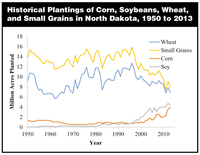Spotlight on Economics: N.D. Cropping Practices Past, Present and Future
(Click an image below to view a high-resolution image that can be downloaded)
By David C. Roberts, Assistant Professor
NDSU Agribusiness and Applied Economics Department
Historically, North Dakota has been a large producer of small grains, including wheat, barley, oats and rye. According to data collected by the National Agricultural Statistics Service, the total area of small grains planted in the state between 1942 and 1996 averaged 13.9 million acres annually, while the total combined area of corn and soybeans was a mere 1.2 million acres. During this historical period, corn and soybeans were not suitable as production substitutes for small-grain crops.
Since the mid-1990s, however, major technological and market changes have occurred, resulting in corn and soybeans being more profitable than small grains in much of North Dakota.
The increased profitability of corn and soybeans has resulted from several economic drivers, including high export demand for use in livestock operations and increasing domestic demand for fuel-grade corn ethanol, as well as new biotechnologies and breeding efforts that have reduced production costs for these crops.
In 1996, small grains accounted for 71 percent of all cropland in North Dakota, while corn and soybeans combined accounted for only 7 percent. In 2013, small grains account for only 38 percent of planted acres, while corn and soybeans together account for 40 percent of plantings.
Farmers have diversified their crop selections to reduce the risk of diseases, pests and price volatility. These changes have been beneficial to North Dakota’s farmers and to the state’s economy in general. However, there may be tradeoffs that are predictable but, as yet, not thoroughly studied. North Dakota is facing rapid changes in land cover as a result of these economic forces, which could be the largest, most rapid changes since the early 20th century, when the railroad and commercial agriculture spread through the state.
I’m working on research to quantify the effects of technological changes and public policy initiatives on crop selection in North Dakota and, ultimately, to determine the potential impact on the state’s natural resources, including wildlife habitat and water quality, as well as other natural resources.
I’m creating a database of annual crop selections at the field level for the Sheyenne River Basin that will allow me to track the expansion and contraction of areas planted to various crops, and to find statistical relationships at a very fine spatial resolution among crop selection and crop prices, input prices, soil types, climate and many other variables.
The understanding of these relationships will help explain recent agricultural history quantitatively, and also will permit the extrapolation of agricultural trends in the near future.
Recent and projected changes in cropping patterns will allow the study of environmental change as it relates to agriculture. For example, this modeling effort will allow me to make inferences about potential effects on pheasant habitat in tall prairie grass and wheat fields, which is a topic of great interest to hunters and farmers.
Linkages between agriculture and surface water quality in the Sheyenne River also will be studied. Understanding these linkages will be vital to promote effective agricultural policy.
These are exciting times in North Dakota agriculture. I anticipate continued excitement and prosperity in this sector of our economy.
NDSU Agriculture Communication – Oct. 2, 2013
| Source: | David C. Roberts, (701) 231-9796, david.c.roberts@ndsu.edu |
|---|---|
| Editor: | Rich Mattern, (701) 231-6136, richard.mattern@ndsu.edu |



